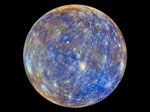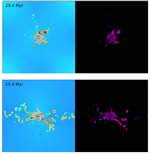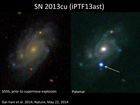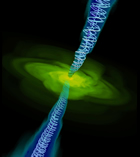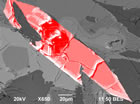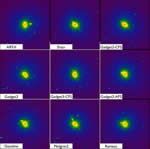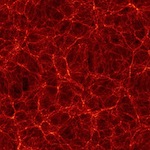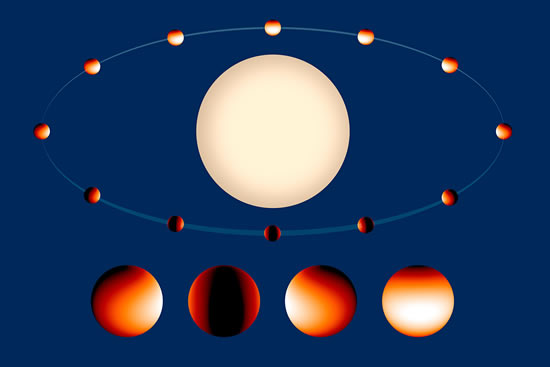Word doc
PDF (formatted and ready to go as a single newsletter page)
Wild Weather on WASP-43b
You thought finding planets around stars hundreds of light-years away was spectacular, exceeded only by determining their sizes and orbits.
Well, in the ongoing exoplanet version of the game “can you top this?” comes another phenomenal feat: discerning the weather on a distant exoplanet—including sensing water vapor in its atmosphere.
Artist’s conception (not to scale) shows exoplanet WASP-43B orbiting its orange dwarf host star. The four images below show close-ups of the planet at points in its orbit 90 degrees apart. (Transits and eclipses are not shown.) Credit: NASA, ESA, and Z. Levay (STSci)
The planet is WASP-43b, orbiting a deep orange dwarf (at spectral class K7, as orange as a star can be without being a red dwarf) a tenth the size of the Sun, and with a cooler surface temperature (maybe 7,500°F compared to 10,000°F for the Sun, a G2 star). A whopping 260 light-years away in the constellation Sextans, you’d need an 8-inch telescope under dark skies even to pick out the host star (magnitude 12.4).
Like just about every other exoplanet discovered so far, WASP-43b is no vacation spot. The planet is the size of Jupiter but twice as massive. Indeed, the planet is slightly more than a tenth the diameter of the star itself.
Worse, it is in a nearly circular orbit less than a million miles from its star’s surface—closer than four times the distance of the Moon from Earth: so close that it orbits the star in a year of just 19.5 hours. Its day is also 19.5 hours long because the planet’s rotation is tidally locked: one side always faces the star and suffers permanent day while the other side has permanent night.
What does all that mean for its weather?
To find out, a team of astrophysicists—including Jonathan Fortney at the University of California, Santa Cruz (UCSC)—combined two observational techniques for the first time and dove deeply into the data.
Emission and transmission
The team secured several precious days of observing time on the Hubble Space Telescope in November and December 2013 to obtain measurements of the planet over three nearly consecutive orbits with Wide Field Camera 3. They also acquired data from three primary transits (where the planet crossed directly in front of the star) and two secondary eclipses (where it passed behind the star), observing in the thermal (heat) near infrared at wavelengths of 1.1 to 1.7 micrometers (μm) using an instrument called the G141 grism. They supplemented the HST observations with high-precision observations from NASA’s Spitzer infrared space telescope at slightly longer wavelengths (3.6 and 4.5 μm).
During transits, they measured how the host star’s light filtered through the planet’s atmosphere—a technique called transmission spectroscopy—to determine the abundance of any water vapor in the atmosphere where the day side transitions to the night hemisphere. Also at different points during transits, they used a technique called emission spectroscopy to monitor the heat emitted at night by the planet itself.
Using custom software run on the Hyades supercomputer cluster at UCSC, they used the extracted spectra to provide a comprehensive view into WASP-43b’s atmosphere, including how temperatures change with height around the planet. They were also able to map temperatures and water abundances in the atmosphere at different longitudes across the planet’s day and night sides—an entirely new technique.
“The emission spectrum shows strong evidence for water absorption,” the authors wrote in The Astrophysical Journal Letters. The Spitzer data also suggest that carbon monoxide and carbon dioxide exist in the atmosphere. The place seems to be too hot for clouds.
Easier than measuring Jupiter
Studying the exotic inferno WASP-43b 260 light-years away actually may shed light on our own solar system.
“Even though Jupiter is much closer to Earth, the composition of its atmosphere is actually harder to study than WASP-43b’s.” Fortney explains. “Our own solar system’s giant planet is so cold that most of its important molecules are hidden in clouds far below the visible atmosphere. The high temperatures of ‘hot Jupiters’ such as WASP-43b make studying their atmospheres easier.”
How hot? WASP-43b’s day side is hot enough to melt iron (2,700°F); the night side is much “cooler”—at 900°F it would “only” melt lead. For perspective, that makes the night side as comfortable as Mercury’s day side—maybe worse, because of WASP-43b’s humid atmosphere. Because heat is so poorly distributed through its atmosphere, fierce hot winds roar from the day side to the night side.
The team hopes that their measurements can reveal more about the conditions under which planets form. “These observations with Hubble show us that we can understand the makeup and weather of giant planets around other stars with current telescopes,” Fortney says. “Thus, they are an important step towards characterizing the atmospheres of more Earth-like worlds with future, specialized space telescopes.” –Trudy E. Bell, M.A.
Further reading: The findings appeared in two articles: “A precise water abundance measurement for the hot Jupiter WASP 43-b” in the October 1, 2014 issue ApJ Letters, and “Thermal structure of an exoplanet atmosphere from phase-resolved emission spectroscopy,” in Science on October 9.See also the NASA press release “Hubble reveals most detailed exoplanet weather map ever” at http://www.spacetelescope.org/news/heic1422/ . A time-lapse video of the data as WASP-43b rotates/revolves appears at http://astro.uchicago.edu/~kbs/wasp43b.html.
The University of California High-Performance AstroComputing Center (UC-HIPACC), based at the University of California, Santa Cruz, is a consortium of nine University of California campuses and three Department of Energy laboratories (Lawrence Berkeley Laboratory, Lawrence Livermore Laboratory, and Los Alamos National Laboratory). UC-HiPACC fosters collaborations among researchers at the various sites by offering travel and other grants, co-sponsoring conferences, and drawing attention to the world-class resources for computational astronomy within the University of California system. More information appears at http://hipacc.ucsc.edu.

